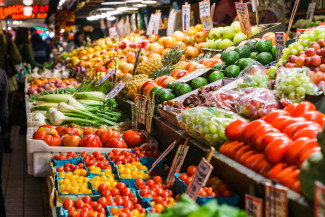
Johns Hopkins UniversityEst. 1876
America’s First Research University
Movable Markets: Food Wholesaling in the Twentieth-Century City

Movable Markets is the untold story of the evolutionary movement of the wholesale marketplace for fresh food in the United States from central produce districts to planned industrial parks on the urban periphery. Whereas food histories have traditionally focused on production and consumption, Movable Markets follows the wholesalers, the middlemen who handled goods as they moved from the producer to the consumer, to more fully understand how cities are fed. Wholesalers became functional necessities in the late nineteenth-century, when the railroads accelerated the process of delivering perishable food to the city.
In the early decades of the twentieth-century, progressive city planners and agricultural economists questioned the centrality, aging infrastructure, and organizational structure of wholesale markets in response to anxieties about the high cost of living, traffic congestion, and disruptions in the food supply. They promoted the unification of wholesale dealers in standardized building complexes with covered platforms on large tracts of land with direct connections to water, rail, and road transportation—located on industrial sites and based on plans largely developed and disseminated by the USDA. Implemented with rigor after World War II, the USDA model rendered many downtown produce districts obsolete as wholesale dealers relocated to new truck-centered facilities located outside of the center city.
Movable Markets enlivens city and regional planning history by explaining the complex process of relocating the food trades from their historic central location; and it engages economic and cultural history by balancing the popular literature on attitudes about the middleman and his place in the food distribution system with the influential publications of agricultural economists in the USDA and in academe.

The quest to provide fresh food to urban populations by whatever legal, physical, or organizational means accounted for the disappearance of the central produce district as a major component of the city, and in its place are the food industrial parks that stand as testament to the loss of food wholesaling from the public sphere. Yet the trade adjusted to life beyond the city limits as it created new channels of distribution, produce lines, and markets; and recent trends indicate a renewed interest in urban locations for the wholesale sector of the food economy.
Memory and nostalgia loomed large in the minds of dealers, suppliers, and their customers who faced moving their places of exchange from historic quarters in the city center to planned wholesale markets located in semi-industrial zones. For the generations who had passed their lives in and around large city marketplaces in the United States or in their home countries, the market’s visible and olfactory presence reassured them that a food provisioning system, though seemingly chaotic, was in place. Many of us can still recall the sights, sounds, tastes and smells of a fish market on the waterfront; produce wilting in crates on a busy sidewalk in the heat of the summer; and the noise and congestion of food delivery trucks. We remember stopping by the produce district for lunch or on the way home from work for a meal or snack; venturing back into town on the weekend with the car to pick up a bushel of peaches or live crabs in season; or meeting friends for a market-fresh meal at an all-night diner. Whether we knew it or not, we were entering the world of the wholesalers, an experience one never forgets or regrets. It is the strength of this memory—of the wholesale marketplace for fresh food as a fundamental urban component—that informs food systems today, as we witness a proliferation of city farmers’ markets, farm-to-table restaurants, and the redevelopment of warehouse districts as food destinations.
Helen Tangires is the administrator of the Center for Advanced Study in the Visual Arts at the National Gallery of Art. She is the author of Movable Markets: Food Wholesaling in the Twentieth-Century City, Public Markets and Civic Culture in Nineteenth-Century America, and Public Markets.


